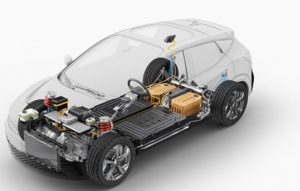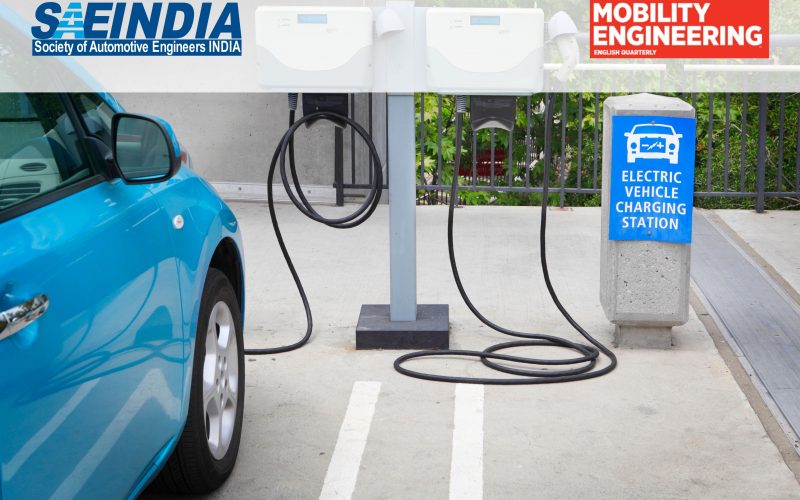Systems Thinking for Mobility Engineers
1. Introduction
A conscious shift to sustainable modes of mobility is a global trend that is rapidly transforming the landscape of the Indian automotive industry. Electric Vehicles (EVs) are expected to play a key role in accelerating India’s transition to sustainable mobility. The transition to EVs is attractive as they are intrinsically energy efficient. EVs convert over 75% of the electrical energy from the grid to power at the wheels while conventional petrol vehicles only convert about ~ 30% of the energy stored in fuel to power at the wheels. EVs are environmentally friendly as they emit no tailpipe pollutants. EVs are attractive from their performance as the electric motors provide quiet, smooth operation and stronger acceleration and require less maintenance than internal combustion engines (ICEs). In an EV, instant torque is generated by the electric motor, whereas an ICE takes time to combust gas and turn the crankshaft.
The transition from ICE to EVs is quite complex due to the multidimensional nature of electric mobility. Analysing the electric mobility ecosystem in India is similar to the challenge faced by the six blind men who tried to describe an elephant in the Indian parable. Just like the elephant, electric mobility consists of inter-related parts that are significantly more important when put together than when considered separately. The first layer of complexity emerges from the fact that electric mobility is at the convergence of multiple technologies and industries. The EV technology, when combined with connected vehicle and autonomous driving technologies, has tremendous disruptive potential. A new mobility industry is arising at the convergence of the traditional automotive industry, infrastructure industry and the power industry. EVs would critically depend on the charging infrastructure and clean electricity to realise their true potential of enabling green and sustainable mobility. The adaption of EVs by the Indian customers will be greatly accelerated when their range anxiety is effectively addressed and a hassle-free charging solution is provided through technology innovations.
The central message of our paper is that the design of electric vehicles (EVs) requires systems thinking. It is evident that we cannot build a high performance EV just by integrating a battery pack with maximum energy storage capacity, an electric motor with maximum torque and power, control systems and other components. The optimization of EV’s performance happens at the interface of these components and sub-systems. Let us consider, as an example, the case of increasing the range of EV. If we try to achieve this goal by using a bigger battery pack, then we would be increasing the weight of the battery. EV batteries usually weigh 20 – 25% of the total car weight. Beyond a limit, the additional weight will start reducing the range of the EV. A bigger battery would also significantly increase the cost and the charging time. If we think of using a structural battery, then we have to consider its impact on performance related to crash, durability, driving dynamics NVH etc. Engineers designing EVs should be proficient in systems thinking and multi-disciplinary optimization.
2. Introduction to Systems Engineering
System is defined as a set of components that are interconnected to achieve a desired performance from the interconnected components [1]. The resultant functionality at system level is more than the sum of functionality of individual components. Systems can either be Physical or Conceptual, or a combination of both. In System Engineering, we deal with both physical as well as conceptual systems. Let us discuss, as an example, the Power Train System in an EV. The major components of a Power Train System are a battery, traction inverter and an electrical machine. Working of Power Train System or any of its components are governed by the laws of physics and hence are referred to as physical systems. However, these systems are designed and optimized based on the requirements set by the customers. Customer engineering activities like discussion with the customer, understanding and documenting the requirements, design prototyping and upscaling etc. are a part of the conceptual system which requires a human interference, and such systems are not governed by law of physics. A detailed analysis of how mobility engineers can understand the customer needs and design mobility products that precisely address those needs has been described as a five step design thinking process (empathize, define, ideate, prototype and validate) in a series of three papers by Sayantan and Shankar [2-4].
It may be noted that, the best performing components integrated together will not result in best performing systems. During the design of a System, it needs to be ensured that both bottom up and top down approaches are followed in tandem to make system performance optimal, making full use of component functions without violating any of the limiting boundary conditions at the component level. Achieving this optimal performance at the system level is one of the biggest challenges in System Engineering. A team of engineers work together at component level (Component Design Engineer) and system level (System Design Engineer) to ensure that they achieve this. However, in reality it may so happen that these engineers are separated by different organization, or by different team in the same organization or components are imported, and in all such situations achieving the common goal becomes difficult and challenging. Subash et al have elucidated how systems and architectural thinking can help engineers in automotive design [5].
Mathematical Modelling
Mathematical modelling or representation of a physical system through mathematical equations is an important step in the analysis of physical systems. However, the depth and approach to modelling is different for both Component and System engineers as detailed below. A Component Design Engineer uses detailed component models with FEA (finite element analysis), multi physics optimisation etc. e.g.: Design of an electrical machine involves Electromagnetic analysis, stator design, no of slots, shape of the slot, selection of number of poles, type of windings –concentrated or distributed, selection of material, thermal considerations, mechanical forces etc. A system engineer on the other hand uses a black box approach where he defines the system boundary and input and output. He will be interested only in establishing the relationship between input and output in a simplified manner. E.g., For the same electrical machine, the system engineer will try to establish relation between AC power supply input to the output Viz Torque and power at various speeds. The relationship between the input and output in System Engineering is represented by set of differential equations or algebraic equations or through look up tables. A Component Design Engineer specifies the design limit of the components like max temp., pressure, current, voltage, speed, torque etc. The system engineer on the other hand analyses the interactions between the components and try to take best from each of the components without violating the above design limit conditions set by component engineer.
The activities done by a component engineer and system engineer are captured in Table below.
Component Engineer System Engineer
Detailed mathematical models – Typically Partial Differential Equations and Finite Element Analysis Mostly Differential and Algebraic Equations
Multi physics simulation ( eg. Electromagnetic, Thermal and Structural analysis along with optimization as in case of an Electrical machine design) Abstracted information only (e.g. Electrical machine or battery pack simulation will have only simplified models)
Detailed understanding of every part of the components in the System Mostly black or grey box approach (establishes input and output relations and interactions only)
Accuracy of simulation is crucial Accuracy is secondary
Component design simulation typically takes a lot of computation time Simulation needs to be fast
|
Component Engineer |
System Engineer |
|
Detailed mathematical models – Typically Partial Differential Equations and Finite Element Analysis |
Mostly Differential and Algebraic Equations |
|
Multi physics simulation ( eg. Electromagnetic, Thermal and Structural analysis along with optimization as in case of an Electrical machine design) |
Abstracted information only (e.g. Electrical machine or battery pack simulation will have only simplified models) |
|
Detailed understanding of every part of the components in the System |
Mostly black or grey box approach (establishes input and output relations and interactions only) |
|
Accuracy of simulation is crucial |
Accuracy is secondary |
| Component design simulation typically takes a lot of computation time |
Simulation needs to be fast |
Table 1 : Activities of component engineer Vs System engineer
3. Designing an Electric Vehicle

Figure 1: A Typical Electric Vehicle

Figure 2 : System Engineering approach for Component Design
The System Engineering as depicted in Figure 2 is an holistic approach in designing the system viz. Electric Vehicle in this case [6, 7]. There are some typical system level performance parameters that needs to be set as detailed by the customer requirements such as vehicle acceleration, Power, Max speed, Gradability and Range. A system engineer needs to make the correct choices of various components and its combinations and create a design prototype of the entire system to meet these requirements as a part of System Engineering. Let us investigate some of the design criterion that are necessary to build an Electric Vehicle.
Electric Machine: Electrical machine is the core part of the electrical vehicle. There are several choices for an electrical machine like the PMSM machines, Induction machines, switched reluctance machine, Axial flux machines or BLDC machines. The PMSM machine is widely used and has highest torque to weight ratio, high efficiency and is compact in size for a given specification. However, it has high cost as compared to other machines. Choice of each machines has its pros and cons. The selection of machine need to be done by considering all this factors.
In addition , there are many choices available for connecting the motor to the wheels. Single speed drive systems, front or rear axial drive or even advanced all-wheel drive are the options. These also will have an impact on the overall system performance.
Battery: Another criterion to meet the requirement is the selection of cell chemistry. Some parameters that need to be looked into are energy density, power density, cost, safety, life span and performance of each cell chemistry.
Electronics: Choice of power electronics consists of selection of semiconductor technology (SiC for example), traction invertor topology, switching strategy etc.
Control algorithm: Control algorithms plays an important role in the overall operation by enhancing the performance of the interconnected components.
Operational Temperature: All the EV components are very sensitive to temperature, and this is yet another criterion to be considered during the design. Temperature at the time of operation plays an important role in case of batteries as the temperature has performance and safety impact on the battery pack. Any temperature beyond the design limit will have impact on the performance andfailure of electronic components in electronic controllers. Temperature also has an impact on demagnetization effect in case of machines having permanent magnet and it will affect the insulation failure as well.
Size and Weight of components: Another important consideration in EV component design is the weight and size of the components. Any additional weight is a load on the battery which will impact the range of the vehicle. Volume of components plays a role as there is limited space available for packing the components in a vehicle.
The total cost of Vehicle will influence the customer’s acceptance of the product. The product designer has to control the Bill of Materials (BOM) at every stage of component design and selection. Govt policies, taxation, import duties etc. are other factors while finalizing the EV design. It is important to keep in mind the customer expectations at every step of the product design. Surveying the customer requirements, understanding the needs and implementing the same in the product design along with their cost estimations are all a part of System Engineering.
Overall System Engineering approach to EV design, requires looking into the problem statement from multiple perspective before designing and finalizing on the end-product. In reality it is possible that some of the designs are available and past experience can be made use of and the designer doesn’t have to consider analyzing every aspect from scratch. However along with the past design and experience, he needs to have the analysis done for the present requirement with a vision for the future.

Figure 3 : Approach to do Simulation
Importance of Simulations
Simulation plays an important role in System Engineering as it provides a virtual proto typing feature during the requirement finalization and high-level design iterations in a cost-effective manner. Typically, the governing equations in system simulations are either differential equations or algebraic equations. Understanding these equations and the assumptions made in deriving such equations are extremely important in interpreting the simulation results correctly. In many cases the non-linear equations are assumed to be linear with suitable assumptions or non-linearity is incorporated through look up tables. The simulation engineer needs to follow the steps depicted in Figure 3 including the intermediate step of understanding the physics and mathematics behind the physical system, before getting into the simulation. Simulation tools provides abstracted standard library blocks where the equations are hidden behind. System model requires solvers for solving the equations and the type of solvers depends on the type of governing equations. Selection of suitable solver and appropriate time step for the solver is also a crucial parameter for running the simulations.
Conclusion:
• Systems engineering skills are critical for designing high performance EVs.
• System Engineering is an holistic approach of getting the best from each of the components within defined limiting boundaries of operation for each component.
• The problem statements are analyzed in depth considering various aspects like performance , cost, government policy and regulations, customer expectations etc.
• Requirement gathering, documentation, ideation for solution, prototyping etc are all important part of system engineering.
• Simulation plays an important role in system engineering with low-cost prototyping as the key benefit from simulation.
References
1. System Architecture – Strategy and Product Development for Complex Systems : Edward Crawley, Bruce Cameron , Daniel Selva, © Pearson Education Limited 2016.
2. Design Thinking for Mobility Engineers, Part 1- Empathize & Define, Sayantan Mukherjee and Shankar Venugopal, Mobility Engineering, Vol.9, Issue 1, Jan – March 2022.
3. Design Thinking for Mobility Engineers, Part 2 – Ideate, Sayantan Mukherjee and Shankar Venugopal, Mobility Engineering, Vol.9, Issue 2, April – June 2022.
4. Design Thinking for Mobility Engineers, Part 3 – Prototype & Validate, Sayantan Mukherjee and Shankar venugopal, Mobility Engineering, Vol.9, Issue 3, July – Sept 2022.
5. Systems and Architectural Thinking (SAT) for Mobility Engineers, C Subash, Srinivas Gunti and Shankar Venugopal, Mobility Engineering, Vol.9, Issue 3, July – September 2022.
6. Hannes Hick , Klaus Ku¨pper ,Helfried Sorger : Systems Engineering for Automotive Powertrain Development , © Springer -2014.
7. John G. Hayes, G. Abas Goodarzi : Electric Powertrain Energy Systems, Power Electronics and Drives for Hybrid, Electric and Fuel Cell Vehicles, © 2018 John Wiley & Sons Ltd.
Authors
 Dr. Shankar Venugopal is the Vice President at Mahindra & Mahindra. He leads technology innovation and knowledge management for the automotive and farm businesses. As the Dean of the Mahindra Technical Academy, Shankar is focused on helping young engineers to build future skills
Dr. Shankar Venugopal is the Vice President at Mahindra & Mahindra. He leads technology innovation and knowledge management for the automotive and farm businesses. As the Dean of the Mahindra Technical Academy, Shankar is focused on helping young engineers to build future skills
 Mr Pradeep Kumar Keloth is former Head of Engineering for Electric Vehicle topics for global customers at Bosch Global Software Technology pvt Ltd (former RBEI). He has more than 35 years of experience in system engineering, Control and simulation related topics in Automotive and Nuclear Power plant related applications. He has a short stint as Principle Consultant for Electric Vehicle topic at Skill-Lync a Chennai based leading EdTech company in the education industry. Presently a freelance consultant in the area of strengthening the Academia Industry collaborations
Mr Pradeep Kumar Keloth is former Head of Engineering for Electric Vehicle topics for global customers at Bosch Global Software Technology pvt Ltd (former RBEI). He has more than 35 years of experience in system engineering, Control and simulation related topics in Automotive and Nuclear Power plant related applications. He has a short stint as Principle Consultant for Electric Vehicle topic at Skill-Lync a Chennai based leading EdTech company in the education industry. Presently a freelance consultant in the area of strengthening the Academia Industry collaborations

Poornendhu P T is a Senior Executive at the Mahindra Technical Academy at Mahindra Research Valley. She is a MTech Postgraduate in Electronics and Communication Engineering and has specialized in Signal Processing. She worked as Embedded System Engineer and as a lecturer earlier. She has expertise in PIC microcontrollers and Communication Protocols.



